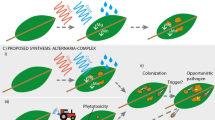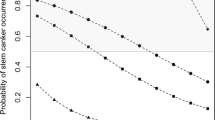Abstract
Alternaria leaf blight is the most prevalent disease of cotton in northern Australia. A trial was conducted at Katherine Research Station to determine (i) the efficacy of the protectant fungicide mancozeb on disease suppression, and subsequent yield and quality of upland cotton; (ii) the disease development at various canopy levels; and (iii) the prevalence of the Alternaria pathogen during the cotton growing season. The protectant fungicide, mancozeb, significantly (P<0.05) reduced disease incidence (85% to ≤74%), severity (2 to ≤1.94) and leaf shedding (1.59 to ≤1.32). It also reduced disease severity on cotton bolls from 2.28 (control) to≤1.04 (fungicide treated). No significant effects of Alternaria leaf blightwere observed on the yield and quality of cotton fibre. Significantly (P<0.05) higher disease incidence, severity and defoliation were observed at the lower canopy (1–7 nodes) level irrespective of treatments. The middle canopy (8–14 nodes) had the next highest incidence, severity and defoliation. The least disease and defoliation were observed at the top canopy level (15+ nodes). Disease development at various canopy levels of cotton plants during the growing season were predicted by a logistic model (R 2 ranges from 0.58 to 0.98). For all treatments, predicted disease development on control plots was faster than that on treated plots. A. macrospora was the most prevalent pathogen during the early growing season and A. alternata was more prevalent towards the end of the growing season. In total, 16–65% of lesions were colonised by both A. macrospora and A. alternata.
Similar content being viewed by others
References
Alagarsamy G, Krishanamohan G, Jeyarajan R (1989) Field evaluation of fungicides against leaf spot of cotton caused by Alternaria macrospora. Indian Journal of Plant Protection 17, 105–106.
Baird RE (2001) Alternaria leaf spot. In ‘Compendium of cotton diseases’. 2nd edn. (Eds TL Kirkpatrick, CS Rothrock) pp. 20–21. (American Phytopathological Society: St Paul, MN)
Bashan Y (1994) Symptom expression and ethylene production in leaf blight of cotton caused by Alternaria macrospora and Alternaria alternata alone and in combination. Canadian Journal of Botany 72, 1574–1579.
Bashan Y, Hernandez-Saavedra NY (1992) Alternaria-blight of cotton: epidemiology and transmission. In ‘Alternaria biology, plant diseases and metabolites. Topics in secondary metabolism.Vol 3’. (Eds J Chelkowski, A Visconti) pp. 233–266. (Elsevier Scientific Publishers: Amsterdam)
Bashan Y, Levanony H, Or R (1991) Association between Alternaria macrospora and Alternaria alternata, causal agents of cotton leaf blight. Canadian Journal of Botany 69, 2603–2607.
Bashi E, Sachs Y, Rotem J (1983) Relationship between disease and yield in cotton fields affected by Alternaria macrospora. Phytoparasitica 11, 89–97.
Bellgard S (2001) ‘Northern cotton disease survey.’ (Australian Cotton Cooperative Research Centre: Narrabri)
Bellgard S (2002) Variation in the incidence and severity of Alternaria leaf spot in relation to irrigation-type and cultivar at KRS 2000–2001. Technical Report. Australian Cotton Cooperative Research Centre, Narrabri, New South Wales.
Bhuiyan SA, Boyd MC, Dougall AJ, Martin C, Hearnden M (2007) Effects of foliar application of potassium nitrate on suppression of Alternaria leaf blight of cotton (Gossypium hirsutum) in northern Australia. Australasian Plant Pathology 36, in press. doi: 10.107/AP07051
Colson-Hanks ES, Allen SJ, Deverall BJ (2000) Effects of 2,6-dichloroisonicotinic acid or benzothiadiazole on Alternaria leaf spot, bacterial blight and Verticillium wilt in cotton under field conditions. Australasian Plant Pathology 29, 170–177. doi: 10.1071/AP00030
Ellis MB (1971) ‘Dematiaceous Hyphomycetes.’ (CAB International: Wallingford)
Ephrath JE, Shtienberg D, Drieshpoun J, Dinoor A, Marani A (1989) Alternaria alternata in cotton (Gossypium hirsutum) cv. Acala: effects on gas exchange, yield components and yield accumulation. Netherlands Journal of Plant Pathology 95, 157–166. doi: 10.1007/BF01999971
Kruskal WH, Wallis WA (1952) Use of ranks in one-criterion variance analysis. Journal of the American Statistical Association 47, 583–621. doi: 10.2307/2280779
Nehl D, Allen S (2002) Cotton diseases: threats and emerging threats. Available at http://cotton.pi.csiro.au/Publicat/conf/coconf02/soilhelt/ 087/087.htm [Verified 3 July 2007]
Nehl D, Kochman J, Bellgard S, Allen S (2000) ‘Northern Australian cotton disease survey.’ (Australian Cotton Cooperative Research Centre: Narrabri)
Nwanosike MRO, Adeoti AA (2002) Evaluation of four fungicides for control of cotton leaf spot caused by Alternaria macrospora Zimm in Nigeria. ASSET Series A: Agriculture and Environment 2, 165–171.
Padaganur GM, Hiremath RV, Basavaraj MK (1989) Estimation of yield loss due to Alternaria leaf spot and blight in cotton. Journal of the Indian Society for Cotton Improvement 14, 144–145.
Rotem J (1994) ‘The genus Alternaria — biology, epidemiology and pathogenicity.’ (The American Phytopathological Society: St Paul, MN)
Rotem J, Eidt J, Wendt U, Kranz J (1988) Relative effects of Alternaria alternata and A. macrospora on cotton crops. Plant Pathology 37, 16–19. doi: 10.1111/j.1365-3059.1988.tb02190.x
Shtienberg D, Dreishpoun J (1991) Suppression of Alternaria leaf spot in Pima cotton by systemic fungicides. Crop Protection (Guildford, Surrey) 10, 381–385.
Siegel S, Castellan NJ (1988) ‘Nonparametric statistics for the behavioural sciences.’ 2nd edn. (McGraw-Hill: New York)
Simmons EG (2003) Alternaria themes and variations (310–335) species on Malvaceae. Mycotaxon 88, 163–217.
Author information
Authors and Affiliations
Corresponding author
Rights and permissions
About this article
Cite this article
Bhuiyan, S.A., Boyd, M.C., Martin, C. et al. Development of Alternaria leaf blight on north Australian cotton (Gossypium hirsutum), species prevalence, and its control using mancozeb. Australasian Plant Pathology 36, 488–497 (2007). https://doi.org/10.1071/AP07055
Received:
Accepted:
Issue Date:
DOI: https://doi.org/10.1071/AP07055




